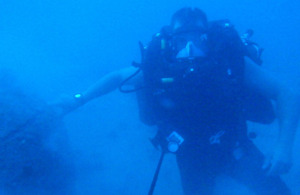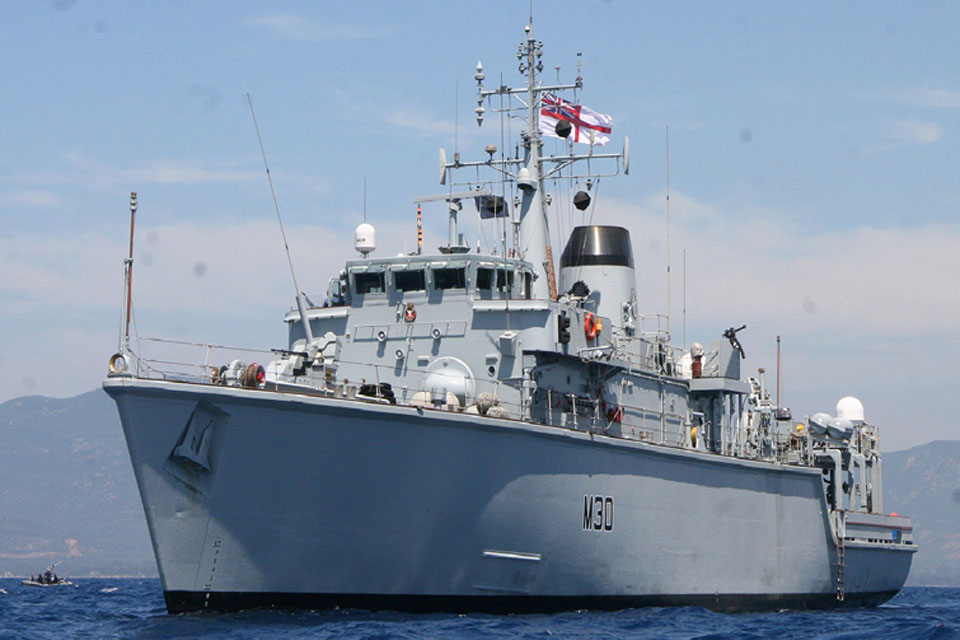HMS Ledbury destroys mine in Mediterranean
Royal Navy divers from HMS Ledbury have helped to blow up a Second World War mine found off Sardinia's busiest port.

Leading Diver Ben 'Duncs' Duncan, one of the Mine Clearance Divers serving onboard HMS Ledbury, pictured with the mine just visible to his right [Picture: Crown Copyright/MOD 2012]
The Portsmouth-based minehunter discovered the mine in the Bay of Cagliari and a joint effort by her divers and their Italian counterparts blew up the aged explosive device.
HMS Ledbury was on patrol with a NATO task group off the Sardinian capital Cagliari when her world-beating sonar picked up a contact on the seabed.
That prompted Ledbury’s team to launch their remote-controlled robot mine disposal system, Seafox, which beamed back a live video feed to the warship’s operation rooms.
Seafox is used both to identify objects and also dispose of them, courtesy of the explosive charges it carries.
In this instance, however, there was so much marine growth on the mine that it needed a first-hand inspection from Ledbury’s specialist mine clearance divers.

HMS Ledbury maintains position in the Bay of Cagliari [Picture: Crown Copyright/MOD 2012]
Able Seaman (Diver) Josh Spibey and the ship’s executive officer, Lieutenant Sean ‘Central’ Heaton, donned underwater gear and went down 43 metres to the seabed. Their inspection confirmed the device was a wartime German GY buoyant contact mine.
The mine was designed to be anchored to the seabed, float just below the surface and detonate if struck by the hull of an unsuspecting passing vessel, blowing them apart with up to 335kg of high explosives.
The mine had long since broken away from its mooring and sunk to the floor of the Mediterranean, but it still posed a threat to fishermen or other vessels if it had been moved in rough seas.
Because the mine was inside Italian territorial waters, permission had to be sought from the Italian authorities to destroy it; Ledbury marked the mine with a buoy and went into the port of Cagliari for a planned weekend visit while a decision was made.
Authority was given and, early on Monday morning, 11 June 2012, Ledbury sailed and met up with an Italian bomb disposal unit at the buoy.
Ledbury’s dive team, working with their Italian counterparts, placed 4lb (1.8kg) packs of plastic explosives on the mine and following some help by the Italian Coastguard to shepherd a few local fishermen and yachts out of the area, the combined operation resulted in the detonation of a third of a tonne of explosives.
Because the mine lay so far below the surface, the water pressure suppressed the majority of the explosion - but an impressive shockwave was seen and the sea boiled as the 70-year-old mine blew a large crater in the sea floor, throwing sand and mud up into the crystal clear waters of the Mediterranean.
HMS Ledbury’s Commanding Officer, Lieutenant Commander Tony Williams, said:
The discovery and disposal of this mine has demonstrated once again the professionalism and effectiveness of the Royal Navy’s mine countermeasure capability.
I am immensely proud of the efforts of my team and this is a fitting culmination to a challenging deployment for Ledbury working with our NATO partners.
This success came on the last period of planned minehunting operations for Ledbury and her crew - the ship has been working with NATO’s Standing NATO Mine-Countermeasures Group 2 (SNMCMG2) in the Mediterranean since the beginning of the year alongside Turkish, Spanish, Italian and German counterparts.
HMS Ledbury’s six-month tour is due to finish at the end of the month.